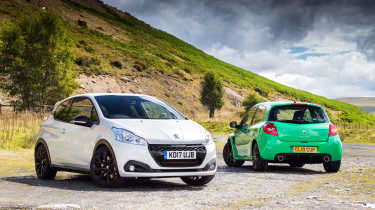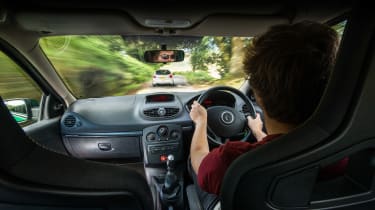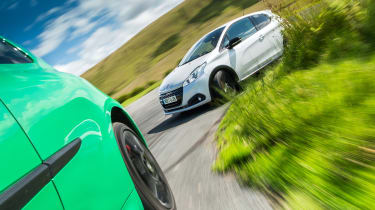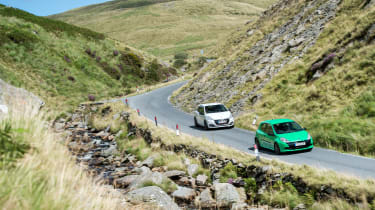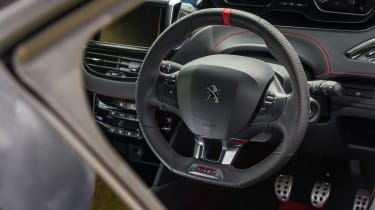Peugeot 208 GTi by Peugeot Sport vs Renaultsport Clio 200 Cup
These are two of France's best hot hatch efforts in recent times, but which will prevail?
After all the fun – the wiggle of the front wheels over a crest, the squealy-tyred passes for the photographer, the sound of an angry four-cylinder reverberating between Welsh dry-stone walls – and long after the cars are handed back to their keepers, evo’s production staff toil away in a stuffy office to ensure our efforts on the road don’t turn into a jumble of incoherent colours, shapes and characters by the time the issue drops through your letterbox.
The most difficult task, I’m told, is trying to reproduce in print the retina-piercing vibrancy of Renault’s alien green metallic paintwork. Thanks to their efforts, the Clio 200 Cup you see here undoubtedly looks fantastic on the page, but for the full experience of its bulldog bodywork extensions and amphibious hue there’s nothing quite like setting it against an Elan Valley backdrop and drinking in the details.
> Click here for our review of the Peugeot 208 GTi by PS
It’s making the nearby Peugeot 208 GTi by Peugeot Sport look a little like someone has left their rental car behind for a day’s hiking in the valleys. It’s here because, well, it’s our favourite supermini-based hot hatchback of the last few years and about the most focused that was available at any price point, but we’re curious to see whether our fond view of it remains as strong when in context with another of our favourite supermini hot hatches. The Clio 200 Cup is one of our all-time greats, and also represents a naturally aspirated formula no longer available in this class.
If there’s a sense we might be missing out, the Peugeot isn’t making the best first impression to convince us otherwise. Compared with the more visually arresting ‘coupe franche’ (black and blue two-tone) scheme of our long-term 208, the glossy white coachwork and matte black wheels appear somewhat unadventurous next to the tree frog-tinted Cup.
More reviews
Re-focus though and you’ll clock the way the Pilot Super Sports completely fill each slightly blistered plastic arch, and the subtle checkered flag graphic in the front grille. There’s also just a hint of a red stripe in the front grille, and a pair of round tailpipes grouped to the right of what Peugeot’s marketers might have you believe is a rear diffuser. And all four wheels appear pushed to the furthest extremes of the bodywork.
Spawned by the limited-run 30th Anniversary model launched in 2014, the Peugeot Sport gained a Torsen limited-slip differential over standard 208 GTis (and the Clio, which uses an open differential), while it too enjoys a wider track, 22mm at the front and 16mm at the rear. It also sits 10mm lower than a regular GTi, with spring rates up an eyebrow-raising 80 per cent. Both wear uprated brakes behind their sizeable alloy wheels.
No risk of mistaking the Clio for a rental unless you’re parked outside Pistenklause. Fellow staffer Will Beaumont has been buzzing around it since I pulled up, telling me how it’s still the best hot hatch he’s ever driven. ‘It’s the footprint that really sets it apart from the 208,’ he reckons, and it’s hard to disagree – sitting in the gravel car park it looks a good foot wider than its compatriot. No mere black plastic extentions here, just serious panelwork so wide that the 197 and its ilk had to be built on a separate production line from cooking Clios.
It too has two tailpipes, but they emerge from either side of an aerodynamic device that stretches far past the trailing edge of the rear bumper, having started somewhere ahead of the rear axle line. And the front arches aren’t just wide – they also feature supercar-style vents to allow pressurised air to escape, reducing front lift.
There’s a wider track than standard, front and rear, along with other surreptitious changes compared with the 197s that preceded the 200 Cup. One was the independent steering axis front suspension set-up cribbed from contemporary Renault Sport Méganes, aimed at quelling torque-steer, as well as stiffer springs front (by 27 per cent) and rear (30 per cent). Dampers were firmed up 15 per cent, while a 7.5 per cent quicker steering rack was used.
I’d opted for the Clio on the way to Wales, having spent plenty of time in the Pug on previous assignments. The potential for a hellish journey is always high on the schlep from Northants and true enough, cloying traffic turns a three-hour trip into a four-hour one. Only it isn’t really hellish. Unless you’re seriously molly-coddled then there’s nothing particularly taxing about a sub-ten-year old car with air conditioning, power steering and a surprisingly pliant motorway gait.
The engine is strong too. When you’ve been spoilt by turbocharging, it’s easy to forget that a naturally aspirated 2-litre engine in a relatively small and lightweight car is more than enough for decent forward momentum, and while you do need to change down to get the best from the F4R 832 unit, that’s no hardship thanks to the six-speed’s gearshift. The wand-like lever may look like it’ll stir through a bag of cockles, but the action is short and it slots swiftly through the gate with a mere flick of the wrist.
Before you even get near any roads worthy of a car with so much development bulging from its arches, the Clio makes you reappraise what’s really necessary from a car like this. The dashboard’s a bit nasty, yes, but we’re not talking Renault 5 flakiness here. There’s no satnav and no USB slot, but the bits that matter – steering wheel, gearknob, seats – are quality items, and everything else simply does the minimum you’d expect of it. If there’s an immediate black mark it’s that the Recaros seem mounted a touch too high, once a common Clio trait.
The Peugeot sits you lower: surprisingly so, in fact, given the divisive ‘i-Cockpit’ dashboard layout with its diddy wheel and raised dials which invite a higher perch. But while it’s one of the more agreeable and tactile cabins in its class, it all seems like tinsel after the Clio’s pared-back environs. The gearknob is more ornate but not any better to hold; same goes for the unusually-shaped steering wheel. The satin-finish pedals might gleam at you from the footwell, yet they might as well be Teflon-coated for all the grip they offer your soles, and they’re ill-positioned for the kind of heel-and-toe action the Clio encourages.
Don’t be fooled. On very first impression, the 208 GTi actually shades the Cup. No, really. It’s more accelerative, more immediate in its steering responses, and stands on its nose more readily when you hit the middle pedal. It’s also just a little easier-going to extract the bulk of its performance, with a lighter touch to all the controls and the feeling you can clip each apex a little tighter without worrying about skimming an extended arch on a granite outcrop.
Be in no doubt, either, that the shift to turbocharging has bred some truly rapid little cars. The sound emitted by the 208’s tailpipes won’t stir the soul but the accompanying pace is rampant if you’re inclined to use all the revs. It won’t protest if you do, either – Peugeot’s 1.6 is a cracking little unit, feeling strong from little more than tickover until the last few rpm before it bats into the limiter.
It’s an exciting car, this, your charge through the gears accompanied by some tugging at the small-diameter wheel –enough to feel like you’re working the tyres (and you really are), but not enough that you’re constantly having to nudge the 208 back on track. Corners will paste a huge grin over your face too, the strong brakes and sharp steering letting you hook the nose right into an apex before sinking the throttle once more and feeling the Torsen fire extra torque to the loaded outer wheel. ‘It responds to the most ludicrously large steering inputs,’ observes Will, ‘and seems to have more turn-in grip than the Clio.’ All the while, the inside rear can be found hanging a few inches from the ground, the grip of its counterpart neither too great to induce understeer nor too little that you’ll have to deal with a spike of old-school Peugeot tail-happiness.
But there’s this nagging feeling in this company that Peugeot has prioritised ability over tactility. Rushing through the gearbox is rendered little more than a necessary process by the slightly clunky, long-winded throw, and when you make that initial movement through the steering, you register its effect through your eyes rather than your palms. The brakes are mighty but the pedal slightly spongy, and great though the engine is, the most minute, feathered movements of the throttle have no appreciable effect.
The Clio delivers all this, and more. The steering feels a little dead, at first, a little gummy off-centre, a little slow to respond. It’s less immediately rewarding than the darty Pug. Work at it: as loads grow through the tyres, as steering angles increase, the Clio’s front end comes alive. Will notes that it doesn’t respond to ham-fistedness. ‘It just doesn’t feel that lively,’ he remarks. The rack is ultra-precise; it’s just a little lower-geared than that of the 208, and the bigger wheel requires you to make more deliberate movements, steering from your shoulders rather than your wrists. The high-set seats encourage you to lean into the wheel too, like a classic Mini. ‘It’s as if the seat is pushing you over the front axle,’ says Will, and once you’re locked into that feeling the low-set Peugeot almost feels removed from the action.
Torque-steer is almost completely absent. The wheel doesn’t tug out of tight corners and it doesn’t hunt on straight but otherwise uneven sections of tarmac. You’re not getting less information than the 208 provides – quite the contrary. The Clio is simply giving you the information that matters. As Will points out: ‘The Peugeot needs its limited-slip diff. It has more torque, but it’s not as linear nor as responsive as the Clio.’ Rare too is a car that feels so locked-down, so abundant in its reserves of grip, yet also so malleable. The Clio sits low and wide but it dances like it’s on its tip-toes.
And the damping… good grief this is good. The older Clio Trophy gets plenty of praise for its remote-reservoir Sachs units but it’s hard to imagine how you could improve the Cup: it’s telling that Renault Sport didn’t go down the Trophy route with this generation. It rides beautifully at speed, yet body control is absolute. Chasing Will in the 208 we thump through a steep dip at speed. I say thump, but the Clio just seems to ignore it, absorbing every millimeter of the compression – no contact with the bump-stops, no graunch of splitter on tarmac – and carrying on as if it was just another minor blemish in the road.
The Peugeot is a fine hot hatchback, a car that blends wieldy size with knockout performance and an engaging chassis, and a car that restored our faith in Peugeot’s ability to operate on the same level it used to in the ’80s and ’90s. ‘The 208 does 90-95 per cent of what the Clio can do,’ remarks Will, ‘but to achieve that it has to have an LSD, super-sticky tyres, and fancy dampers. The Renault simply has an exceptionally well-sorted basic chassis.’
Both the 208 GTi and Clio Cup are essentially modified shopping cars, but the Renault Sport product feels as though it was engineered as a performance car from the ground up. It not only outpoints the Peugeot, it really is one of the all-time greats, regardless of genre or price.

